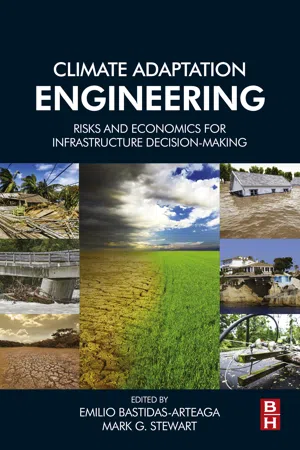1.1 Introduction
Climate change arouses much fear and anxiety in society; and for good reasons, if climate projections are correct, a changing climate will cause sea-level rise, more flooding, and more intense storms and hurricanes, droughts, and other climate extremes. This will affect every nation, and populations in developing countries will be hit hardest. This can, in the worst case, lead to energy and food scarcity, increase the spread of disease, mass migration of ‘climate refugees’, and weaken fragile governments. Urban communities are particularly vulnerable to a changing climate, and “Rapid urbanization and the growth of megacities, especially in developing countries, have led to the emergence of highly vulnerable urban communities, particularly through informal settlements and inadequate land management” (IPCC, 2012).
The focus of this chapter (and this book) is on technological innovation and adaptive behaviours—that is, the future proofing of infrastructure to climate change for future generations, economies, and environments. The impact of climate change on infrastructure performance is a temporal and spatial process, but most existing models of infrastructure performance are based on a stationary climate. For example, the World Bank states that “Despite the ability to quantify future risk (albeit with uncertainty), risk assessments typically fail to account for changing climate, population, urbanization, and environmental conditions” (World Bank, 2016). Hence, there is a need to quantify the costs and benefits of adaptation strategies. Climate adaptation engineering involves estimating the risks, costs and benefits of climate adaptation strategies, and assessing at what point in time climate adaptation becomes economically viable. Climate adaptation measures aim to reduce the vulnerability or increase the resiliency of built infrastructure to a changing climate, this may include, for example, enhancement of design standards, retrofitting or strengthening of existing structures, utilisation of new materials, and changes to inspection and maintenance regimes. Engineers have a unique capability to model infrastructure vulnerability, and these skills will be essential to modelling future climate impacts, and measures to ameliorate these losses.
The climate change literature places more emphasis on impact modelling than on climate adaptation engineering modelling. This is to be expected when the current political and social environment is focused on mitigating (reducing) CO2 emissions. The impacts on people and infrastructure may be considerable if there is no climate adaptation engineering to the existing and new infrastructure. Some posit that climate change may even be a threat to national security, but Stewart (2014) suggests that climate change threats to US national security are modest and manageable. On the other hand, higher temperatures in higher latitude regions such as Russia and Canada can be beneficial through higher agricultural yields, lower winter mortality, lower heating requirements, and a potential boost to tourism (Stern, 2007).
There is seldom mention of probabilities, quantitative measures of vulnerability, or the likelihood or extent of losses in ‘risk’ and ‘risk management’ reports on climate change and infrastructure. While useful for initial risk screening, intuitive and judgement-based risk assessments are of limited utility to complex decision-making since there are often a number of climate scenarios, adaptation options, limited funds, and doubts about the cost-effectiveness of adaptation options. In this case, the decision maker may still be uncertain about the best course of action, and so a detailed risk analysis is required (e.g., AS 5334-2013). For this reason, there is a need for sound system and probabilistic modelling that integrates the engineering performance of infrastructure with the latest developments in stochastic modelling, structural reliability, and decision theory. Such an approach is a logical extension of disaster risk management. The emphasis of the book is built infrastructure. This accords with the World Bank (2016) for the need for the “construction of buildings, infrastructure, and urban developments should consider how design, construction practices, and construction materials will affect disaster risk in both current and future climates”.
The cost to mitigate CO2 emissions is considerable. Stern (2007) estimated that to stabilise CO2 levels at 550 ppm (by reducing total emissions to three quarters of today’s levels by 2050), it would cost 1.0%–3.5% of gross domestic product (GDP), with a central estimate of approximately 1%. The mean estimate would result in an annual mitigation cost of approximately $720 billion. This is a stupendous sum, and so a pivotal question becomes: is this the best option, or are there others? This is the question that Bjorn Lomborg posed to a group of experts—they found that climate change action ranked very low when compared with other hazard and risk-reducing measures, in this case the benefit-to-cost ratio (BCR) for CO2 mitigation was only 0.9 (not cost-effective), but increased to 2.9 for a mix of mitigation and adaptation strategies (Lomborg, 2009). Yohe et al. (2009) found that a global investment of $18 billion per year in ‘R&D (research and development) and mitigation’ can halve ‘business as usual’ CO2 emissions by 2100. Such actions would reduce the impact of climate change by at least 60%. The key here is R&D where innovation can be an important driver to reducing CO2 emissions.
Some of the more dire predictions of food and energy insecurity, and mass migration can be ameliorated by funding climate adaptation measures in the developing world. Adaptation measures to reduce vulnerability of infrastructure, coastal zones, agriculture, forestry, fisheries, and human health to climate change hazards would include: flood control dikes and levees, dams, cyclone shelters, storm and flood-resistant housing, improved communication infrastructure, resettlement of populations to lower risk zones, and improved health care. The World Bank (2010) estimated that the cost to the developing world of adapting to an approximately 2°C warmer world by 2050 is approximately $75 billion per year. This represents about one-tenth of 1% of world GDP. Clearly, investing in targeted a...
